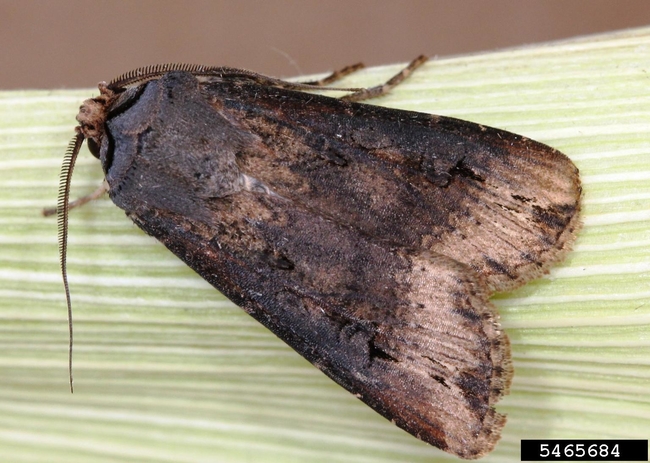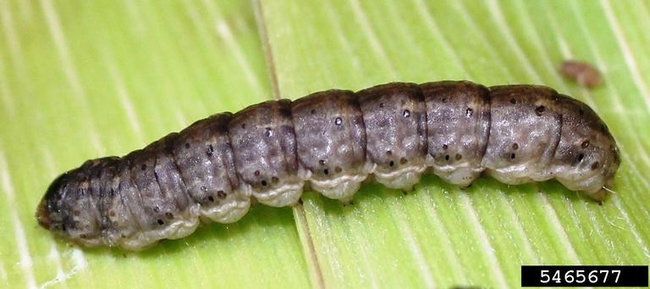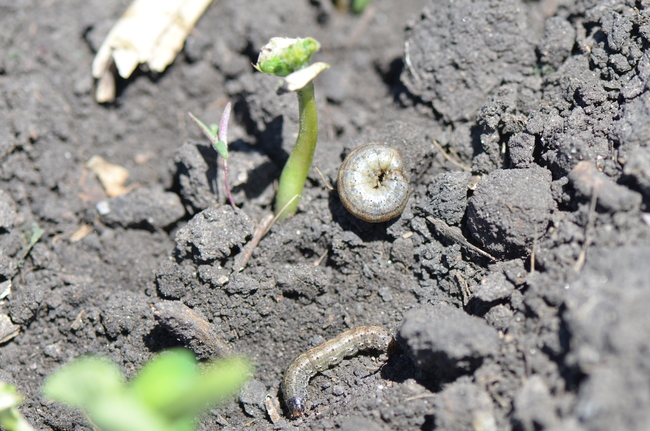This information is specifically for those managing black cutworm on crops.
Identification of Black cutworm (Agrostis ipsilon)
Adults
- Large, heavy–bodied moths with one to two-inch wingspan (Figure 1a).
- Grayish–brown color with forewings having small, black zigzag markings extending the length of each wing.
- Hind wings are off–white with tan borders.
Eggs
Eggs are small, round and white, eventually turning brown. Laid singly or in clusters.
Larvae
- Range in size between one-sixth to one and one-half inches (Figure 1b).
- Color varies from greasy gray to black. A broad light gray band runs down the middle of the back.
- Unequally-sized, paired tubercles run along the upper side of the body.
Pupae
Pupae are dark brown, three-fourths inch long and rarely seen.
Natural history
Black cutworm moths migrate to Minnesota from overwintering sites in the southern U.S. and Mexico in early spring (April). Females seek out low–growing plants and plant residue for egg-laying. After five to 10 days, eggs hatch. Young larvae feed on weeds or soybean leaves and later move to feed on seedling stems. After completing six larval instars, they pupate in the soil, with adults emerging in two to three weeks. There are two to three generations per year.
Impacts
Small larvae feed mainly on leaf tissue and larger larvae can cut cotyledons and stems. The larger larvae feed on plant parts just above the soil surface and occasionally below the surface, if the soil is loose and dry near the base of the plant. Larvae can completely cut off the soybean stem. Even if the stem is not completely cut, enough plant tissue may be removed to cause the plant to fall or wilt.
Scouting and management
Unlike other stand-reducing insects, black cutworm infestations can be controlled with rescue treatments of insecticides, if promptly detected.
Adult moth catch is monitored each year in southern Minnesota using pheromone traps. Using this trap data and a biofix of eight or more moths in a two-night period, degree days can be calculated to estimate when larvae will be present in your fields. More information on monitoring black cutworm can be found on the Cutworm Network page.
Scouting
Black cutworm scouting should start at plant emergence and continue one to two times a week until plants are past V5.
Look for the following:
- Leaf feeding by small larvae
- Wilted or cut plants caused by larger larvae
If any feeding is present:
- Dig around the base of plants and check under debris to find larvae.
- Check 20 consecutive plants in five different areas of the field to determine the percent of plants cut or girdled.
- Concentrate sampling in areas that are more at risk for damage.
Risk for infestation by black cutworm is greater in areas that are attractive for egg laying and include the following:
- Fields with crop debris
- Fields with weeds
- Low areas within fields
Treatment thresholds
- For seedling plants, treat if 20 percent of plants are cut, stand has gaps of one foot or more, and cutworms are present.
- For vegetative plants (before flowering), treat if defoliation from this pest and other defoliators reaches 30 percent (see percent defoliation of soybean leaves).
Labeled rates of insecticides can be used to manage this pest. Follow the directions on the product label.
Estimation of stand loss and replant decisions
Fields should be inspected for stand loss during seedling growth stages. Soybean is a resilient crop, able to tolerate relatively high levels of stand loss. However, when significant stand loss occurs, replanting may be required, but this option should be considered carefully. Information is available on how to estimate plant stand and guide replant decisions in soybean (U of M Extension soybean replant guide). This emphasizes the importance of knowing the field history, previous infestations, and current degree days.
Reviewed in 2024




